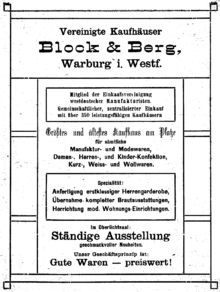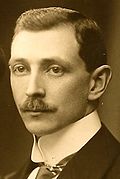Kasseler Strasse 26 (Warburg)
The residential building at Kasseler Straße 26 is an upper-class villa built around 1910 in Warburg , North Rhine-Westphalia, and is a listed building .
architecture
The villa, built in the forms of the late Art Nouveau and under the influence of English country house architecture , consists of a two-storey main building with extensions and a high hipped roof . In front of the street is a single-storey wing with a mansard roof that has been pulled down . This wing has a ground floor, two in stone -made, semi-elliptical window bay (Bay Windows), between which a small balcony niche is. The plastered gable above protrudes twice and also has window bay windows, but these are somewhat smaller and made of wood. On the west side there is a second gable extension with an entrance loggia and staircase . Its roof is curved and pulled down even lower than the street gable. The top of the gable carries a slightly cantilevered visible framework.
Due to its diverse details such as the quarry stone base with pointed grooves, different frames of the windows in ashlar, wood and plaster, the circular decorative plaster elements provided with symbols in the street gable and the differently designed wooden lattice windows with partly colored lead glazing, the house shows a diverse, but still closed Layout. The high-quality decorations of the street-side ground floor windows with figurative representations of the four seasons by working people and geometric reliefs in the lintels are to be emphasized.
The high level of design effort continues inside, including in the form of wall paneling in the vestibule and staircase, stucco decorations on the ceilings in the salon and living room and the original washbasin in the dressing room on the upper floor.
history
The builders and first residents of the house were Hugo Berg (1879–1943) and his wife Mary Berg geb. May (1883-1944). Both came from wealthy Jewish merchant families.
Hugo's father Max Berg (1851-1919) came from a family that had lived in Warburg since 1722 at the latest. Their parent company was the Goldschmidt house in the old town of Warburg, Joseph-Kohlschein-Straße 28. He had married Fanny Block, a sister of the businessman Siegmund Block (1860-1939), lived with his family in the house at Kasseler Straße 4 and was a co-owner of the Block & Berg , the leading textile department store in Warburg at Hauptstrasse 20–22. Hugo's uncle Sally Berg (1857–1924), who emigrated to Brussels in 1873 , was one of the leading fashion designers of the time around 1900 and worked at several textile department stores and companies in Brussels , Amsterdam , Vienna and Paris a . a. involved. Under the influence of the family, Hugo also became a textile merchant and, in 1919, a partner in Block & Berg . Mary May (1883–1944) was a daughter of the Herlinghausen merchant Israel May (1840–1920), who ran the S. May grain wholesaler , founded in 1820, on the property at Kasseler Strasse 13 .
When the villa was built, the property of which was near both parents' houses, Hugo Berg and his wife were 27 years old. They married on January 28, 1910 and had two children: Richard Werner (1911–1944) and Berta Lilly (1914–1943), who grew up in the house with its large hillside garden that stretched as far as the Warburger Mühlengraben.
In World War I Hugo Berg became the cavalry moved in. After the inflation caused by the war ended , the S. May grain trading company was unable to recover economically and went bankrupt in 1925 .
From 1933 onwards, Block & Berg also got into trouble due to the Jewish boycott organized by the National Socialists . In 1934 Hugo Berg sold his villa to the doctor Walter Czerwionka. Block & Berg was sold to the F. and A. Schnorbus brothers, Hallenberg , in 1936 . Hugo's co-managing director Karl Block (* 1896) emigrated on April 15, 1937, first to Milan and later to Lima in Peru , where he was able to re-establish a department store. On March 29, 1939, the Hugo Berg family also emigrated and moved to their relatives in Amsterdam , where they lived at Ruysdaelstraat 124, and their parents found work in the Hirsch fashion house founded there by Sally Berg . In 1941, a year after the attack on the Netherlands, Belgium and Luxembourg , Berta Lilly married another German refugee, Alfred Davids from Darfeld , with whom she had a son, Harry, in autumn 1942. When the young couple was arrested a few months later, however, they were able to hide their child in resistance circles shortly before . Berta Lilly and Alfred Davids were deported to the Sobibor extermination camp and murdered in early April 1943. A little later the other family members were also deported. Hugo Berg died on August 24, 1943 in the Westerbork transit camp . Mary Berg and her son Richard Werner were brought to Auschwitz concentration camp and murdered there on October 14, 1944. Only Harry Davids survived. He was brought to Friesland in barges, where he was taken in by the Berend and Jeltje Bakker families in Engwierum and passed off as their fifth child. In 1947 Harry was found by survivors of his paternal family and was finally adopted by his uncle Paul Davids, who had emigrated to South Africa . He later moved to the USA , where he worked as an accountant in San Diego, among other places . He now lives in Los Angeles , California , and volunteers for the Los Angeles Museum of the Holocaust .
The villa in Warburg has changed hands several times since 1934. It was gradually refurbished in style from the 1980s.
literature
- Hermann Hermes: Deportation destination Riga. Fate of Warburg Jews. Self-published, Warburg 1982.
- Gotthardt Kießling et al .: City of Warburg. (= Monument topography Federal Republic of Germany , monuments in Westphalia, district Höxter , volume 1.1.) (Published by the Landschaftsverband Westfalen-Lippe and the Hanseatic City of Warburg) Michael Imhof Verlag, Petersberg 2015, p. 270 ff.
- Leslee Komako: Hidden in plain sight. In: Jewish Journal of April 23, 2014.
- Walter Seulen: Monuments in the city of Warburg. (= Warburger Schriften , No. 21.) Warburg approx. 1996.
- Museumsverein Warburg (Ed.): Memories 2011. The citizens of the Jewish faith lived among us. Warburg 2011.
Web links
Individual evidence
- ^ Warburg district (ed.), Heinrich Bachmann (arrangement): Warburg district calendar 1921. Warburg 1920.
- ^ Warburg land register, Volume 16, Sheet 177 of March 31, 1934
- ↑ www.joodsmonument.nl
- ↑ Entry in the Jewish memorial at www.joodsmonument.nl , accessed on September 15, 2016
- ^ Page at MyHeritage on Alfred Davids and Berta Lilly Davids with a picture of a memorial stone in Sobibor
- ↑ Leslee Komako 2014 ( Memento of the original from 23 August 2016 in the Internet Archive ) Info: The archive link was inserted automatically and has not yet been checked. Please check the original and archive link according to the instructions and then remove this notice.
Coordinates: 51 ° 29 ′ 20 ″ N , 9 ° 9 ′ 28.5 ″ E





